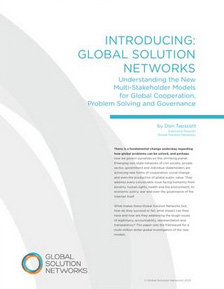For years I’ve argued that every institution needs to move from a “plan and push” mentality to a stance of “engage and co-create.” The new web enables all companies and other organizations to stop shoving things down the throats of employees, customers and other stakeholders and engage them in co-creating value.
There is no industry more ripe for change than education. But not just that we need to change the model of pedagogy from the old broadcast model – teacher focused, one way, one-size-fits-all and in which the student is isolated in the learning process. There is also an historic opportunity to change the way that the administrators who run the system engage all their various constituents. Given that the entire education system needs a massive reinvention why not reach out to the wisdom of the world and use mass collaboration to innovate a new future.
I’m delighted to say that the National Education Association Foundation and the U.S. Department of Education are doing exactly that. They have issued an open invitation to public school K-12 educators nationwide to identify their most pressing classroom problems, and then brainstorm possible solutions online with their colleagues. The best will receive awards and may be selected for further development.
It’s called the Challenge to Innovate (C2i), and should prove to be a great example of the power of crowdsourcing solutions. In announcing the program, Harriet Sanford, President and CEO of the NEA Foundation, said that “We believe that public school educators are most valuable as agents, not objects, of change. Their best ideas are the result of years of study and firsthand, classroom experience. They deserve to be heard and supported. By serving as the conduit for this conversation, we hope to empower innovative educators. We also expect to develop new approaches that will change the way our educators teach and our students learn.”
The Challenge to Innovate has three components. First, it is a social network for educators to trade opinion and information. Second, it is an open invitation for public school educators to share the issues that keep them up at night and the solutions they believe will make a difference. Third, C2i is a challenge to educators to formalize those ideas and be considered for funding and implementation.
From now until Oct. 19, educators are asked to post online their most pressing classroom problems. The problem must be classroom-based, and “relevant to other public school educators; and to teaching and learning in the 21st Century.” Teachers are asked to review, vote for, and comment on the ideas posted. The five highest ranked will be awarded $1,000 for their school.
From Nov. 16 through Jan. 14, educators will post their best solutions to the problems. Solutions must be implementable by public school educators over a three to four month period and cost $500 or less. Individuals can review, vote for and comment on solutions posted. At the end of the review period, up to 10 solutions will receive a $2,500 award for their school from the NEA Foundation.
The winning solutions will also be posted on the Donors Choose website, an organization that encourages the public to make donations for worthy projects in schools. The requests are made by public school teachers, and can range from pencils for a poetry writing unit, to violins for a school recital, to microscope slides for a biology class. Members of the public browse project requests and give any amount to the projects that inspire them. Once a project reaches its funding goal, Donors Choose delivers the requested materials to the school.
It’s a great scheme and is a critical baby step towards a new modus operandi for education, in turn pointing the way forward for the rest of us.





